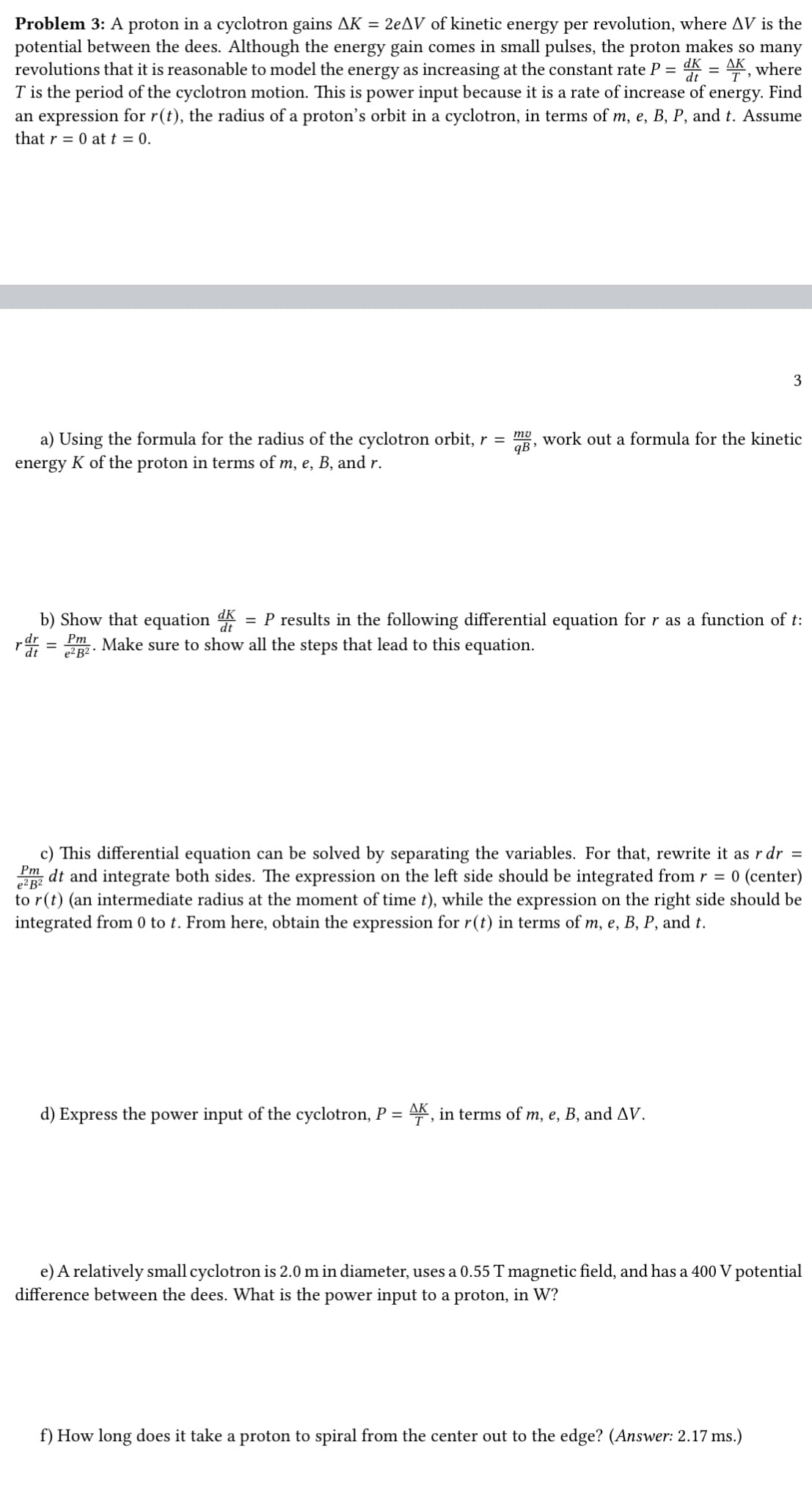blem 3: A proton in cyclotron gains AK = ₂еAV of kinetic energy per revolution, where AV is tr potential between the dees. Although the energy gain comes in small pulses, the proton makes so man dK AK revolutions that it is reasonable to model the energy as increasing at the constant rate P = = wher dt T is the period of the cyclotron motion. This is power input because it is a rate of increase of energy. Fin an expression for r(t), the radius of a proton's orbit in a cyclotron, in terms of m, e, B, P, and t. Assum that r = 0 at t = 0.
blem 3: A proton in cyclotron gains AK = ₂еAV of kinetic energy per revolution, where AV is tr potential between the dees. Although the energy gain comes in small pulses, the proton makes so man dK AK revolutions that it is reasonable to model the energy as increasing at the constant rate P = = wher dt T is the period of the cyclotron motion. This is power input because it is a rate of increase of energy. Fin an expression for r(t), the radius of a proton's orbit in a cyclotron, in terms of m, e, B, P, and t. Assum that r = 0 at t = 0.
Related questions
Question
Hello, I really need help with part e and part f please I don't understand and can you please label them

Transcribed Image Text:Problem 3: A proton in a cyclotron gains AK = 2eAV of kinetic energy per revolution, where AV is the
potential between the dees. Although the energy gain comes in small pulses, the proton makes so many
revolutions that it is reasonable to model the energy as increasing at the constant rate P =
ΔΚ
=
T is the period of the cyclotron motion. This is power input because it is a rate of increase of
an expression for r(t), the radius of a proton's orbit in a cyclotron, in terms of m, e, B, P, and t. Assume
that r = 0 at t = 0.
dK
AK, where
energy. Find
a) Using the formula for the radius of the cyclotron orbit, r = mg, work out a formula for the kinetic
energy K of the proton in terms of m, e, B, and r.
qB'
b) Show that equation d
=
P results in the following differential equation for r as a function of t:
rder= Make sure to show all the steps that lead to this equation.
Pm
e²B2.
3
c) This differential equation can be solved by separating the variables. For that, rewrite it as r dr =
Pm dt and integrate both sides. The expression on the left side should be integrated from r = 0 (center)
e²B²
to r(t) (an intermediate radius at the moment of time t), while the expression on the right side should be
integrated from 0 to t. From here, obtain the expression for r(t) in terms of m, e, B, P, and t.
d) Express the power input of the cyclotron, P = AK, in terms of m, e, B, and AV.
e) A relatively small cyclotron is 2.0 m in diameter, uses a 0.55 T magnetic field, and has a 400 V potential
difference between the dees. What is the power input to a proton, in W?
f) How long does it take a proton to spiral from the center out to the edge? (Answer: 2.17 ms.)
Expert Solution
This question has been solved!
Explore an expertly crafted, step-by-step solution for a thorough understanding of key concepts.
Step by step
Solved in 2 steps with 1 images
